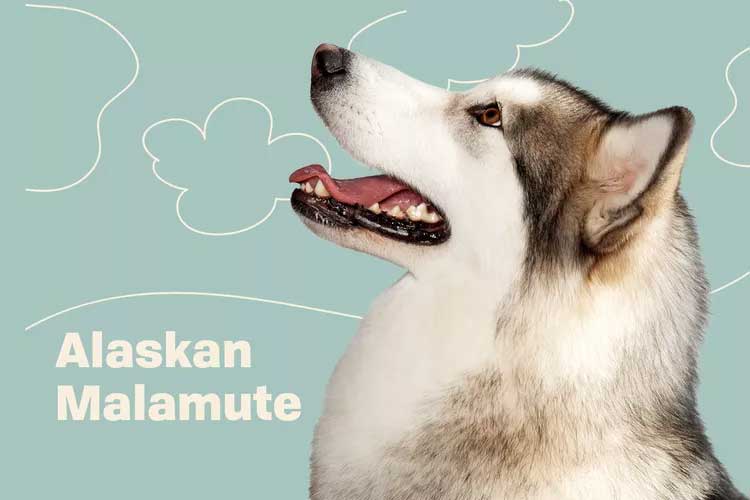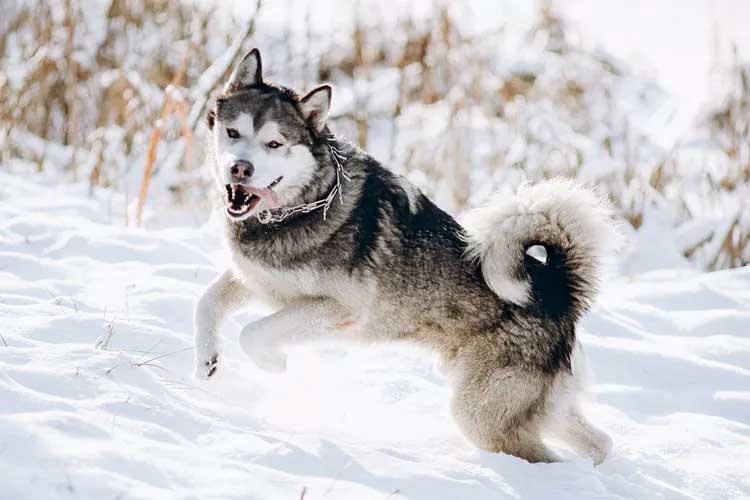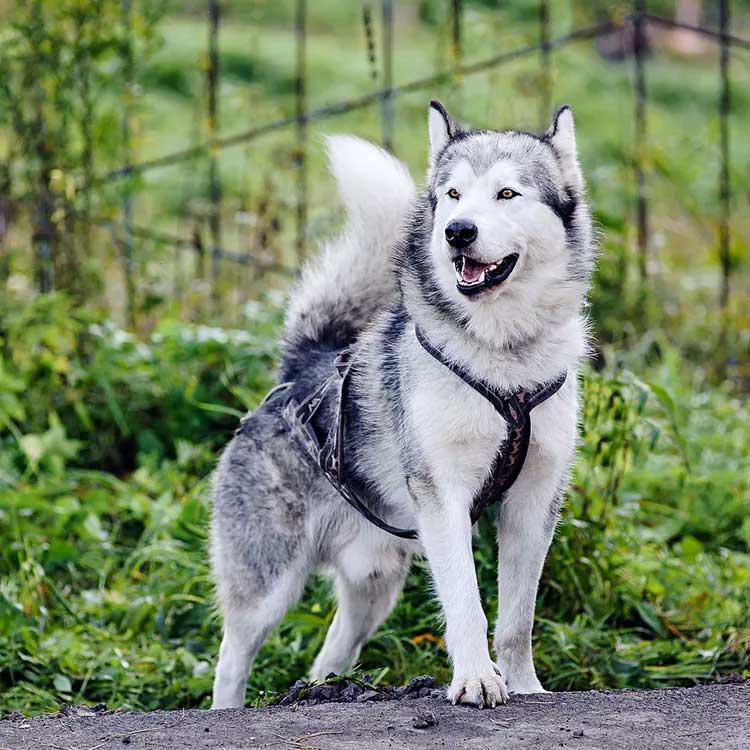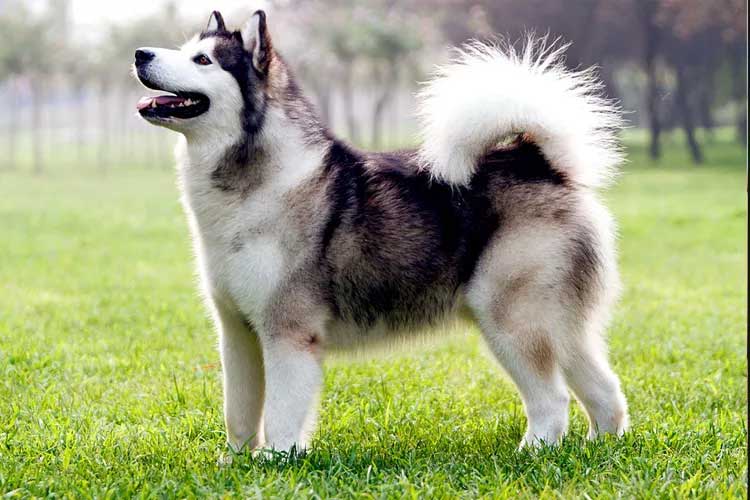Loyal, intelligent, cuddly, and more than a little sassy, Alaskan malamutes apply a dedicated work ethic to everything they do—even playtime! If you’re eager to have one, learn more about their unique personality and needs.

Alaskan Malamute Overview
| OFFICIAL NAME | Alaskan Malamute |
| COMMON NAME | Alaskan Malamute |
| PET HEIGHT | 23 to 25 inches |
| PET WEIGHT | 75 to 85 pounds |
| LIFESPAN | 10 to 14 years |
| GOOD WITH | children, families |
| TEMPERAMENT | friendly, outgoing, playful, willful |
| INTELLIGENCE | high |
| SHEDDING AMOUNT | frequent |
| EXERCISE NEEDS | high |
| ENERGY LEVEL | active |
| VOCAL LEVEL | howler |
| DROOL AMOUNT | low |
| BREED GROUP | working |
| BREED SIZE | large (61-100 lbs.) |
| COAT LENGTH | long |
| COLORS | black, blue, brown / chocolate / liver, gray, red, white |
| PATTERNS | bicolor, sable |
| OTHER TRAITS | cold weather tolerant, easy to groom, good hiking companion, high potential for weight gain, high prey drive, strong loyalty tendencies, tendency to chew |
Whether you need to haul something through the snow or just want a furry friend with bountiful energy for outdoor adventures, the Alaskan malamute is game. These talkative, patient, and affectionate Nordic wonders will use their strength and agility to help around the homestead, thrill your children with exciting sled rides, and explore the wilderness with you.
Mals, as they're affectionately called by their fans, are "big, strong, playful bundles of fur that do just fine in rain, sleet, snow, and ice," says Karen Shaw Becker, DVM, author of Real Food for Healthy Pets and co-founder of Dr. Becker's Bites.
Appearance
Alaskan malamutes are stunning and regal, with a flirty plumed tail curled over their back. Their cheerful and alert expression communicates boundless energy, with bright, almond-shaped brown eyes and a medium-sized muzzle. When they're active, their pointed ears stand upright and even angle back; if they're at rest, their ears will ease a little to the sides of their broad head.
Their athletic, muscular bodies are covered with a double-coat of fur. The exterior is short and coarse, maybe even a tad wooly, while the undercoat is soft and dense. This combination insulates them well during long sled runs in freezing temperatures. A mal's underside is white from the front of their chests to the end of their tails. Their topcoat is typically a range of colors that varies by dog (black, blue, brown, gray, red, sable, seal, and silver are all common). Full white Alaskan malamutes are often the only members of this breed dressed in a solid color coat.
Standing approximately 2 feet tall at the shoulder and weighing between 75–85 pounds, mals are large dogs capable of pulling sleds, wagons, and children on toboggans. They have durable yet graceful legs, thick neck scruff, and slightly-sloped backs.
Temperament
Spirited and clever, malamutes are affectionate entertainers who love their packs. Malamutes are freighters of the Arctic, with incredible endurance to carry heavy loads with their team over long distances. Your mal won't be content lazing around or being left alone for long periods of time.
Because of Alaskan malamutes' size, focused energy, and tremendous abilities, Becker says "puppies should start kindergarten classes as soon as possible, and continue with ongoing fear-free obedience classes through at least their first year." Mals can be strong-willed, so dedicated training ensures you have an exceptional family member. Training might be even more important if you adopt an older pooch.
Although a great companion for children, the friendly, hard-working mal isn't suited for guard dog duties, because as far as she's concerned, anyone at the door must be part of the pack. So channel her focused athleticism in other ways. Extend a leash from your mountain bike, and she'll take lead bounding across hills and valleys. Allow her to carry camping supplies when you go hiking. Harness her to a trailer to haul branches or bags of mulch. The Alaskan Malamute Club of America provides specific safety guides to help you understand her capabilities. A working dog is happiest when she's actively engaged.
Malamutes are sassy, and they talk back with woos, muphs, whimpers, grumbles, yips, and moans. It's easy to engage in a full conversation with a mal and feel you know exactly what she thinks! And yes, they'll howl—it's the song of their tribe, a locator, an "I'm happy!" notice, an "I'm sad you left me alone" cry, and a response to sirens. Help yours control howling with a gentle "quiet" command and a treat as a reward when she complies.
Living Needs
Most malamutes are a little too high energy for apartment living, especially if they have limited amounts of time to be outdoors as a result. Becker says they need daily rigorous exercise that's beyond being outside in the yard.Remember, an Alaskan malamute's temperament requires diligent engagement, so a 30-minute game of frisky fetch might need to happen a couple of times a day. Dog parks are also great options for socialization with canines their size and larger.
Even though pack life is in their DNA, it's essential for them to mingle with other animals in the family while still a pup. Otherwise, they might be tempted to give chase to dogs of the same sex, smaller pooches, and cats. Socializing your Alaskan malamute puppy will help her grow into a well-rounded, and well-mannered, pup!

You won't have to build a fortress if you decide to bring a mal home, but it definitely helps. They're persistent diggers and exceptional jumpers—traits they inherited to survive the harsh Arctic wilderness. Without a way to redirect these skills, they'll wreak havoc to landscaping—and they could even run off. So yard fencing must be at least 5 feet tall and buried 1 foot underground, reinforced with chicken wire or mesh. This way, a mal can romp freely. They're also notorious for chewing crates, gnawing leashes, and finding other ways to escape for an adventure.
Behavioral training helps manage their digging, but doesn't stop it completely. Their instinct is to make a den for protection and hide food, and there's no way around that. So one popular suggestion is to provide a dedicated space for digging (say, a sandpit)—and reinforce that the digging stays there through treats, toys, and games. Also consider regularly visiting an area where digging to their hearts' content might be allowed, such as a beach.
Care
Most malamute owners laugh about the wild amount of fur floating through the air when their dogs shed. There's always a little—well, more than that!—all year, but "blowing coat" happens in the spring and fall, and then fur is everywhere for about a month.
In terms of grooming, daily care with a slicker or bristle brush and a line comb are terrific solutions. They help control shedding, eliminate dirt and mats, and spread natural oils to moisturize the dogs' skin and make the coat glossy. Vets advise against shaving, though, as the mal's double-coat provides essential cold and heat insulation.
All in all, you can handle Alaskan malamute shedding with lint brushes in every room and a powerful vacuum. Because the loose fur is so fluffy and clean, some people actually make yarn from it! That's right: Malamutes are very clean. Most only need baths a few times a year unless they're avid diggers. They often lick themselves tidy after meals, and most don't smell either.
Other aspects to consider regarding malamute care include daily paw checks for foreign objects, frequent home dental care, and regular trims of nails and paw pad fur.
Health
Overall, malamutes are healthy, boisterous dogs who make the most of their 10- to 14-year life span, but there are a few health problems common to the breed. "Alaskan malamutes are prone to hip dysplasia, so making sure a puppy's parents were screened for this disease—with documentation from the Orthopedic Foundation for Animals or PennHip—is very important," Becker says. "Large- and giant-breed puppies should be provided targeted nutrition that allows for metered growth so the musculoskeletal system develops correctly. Offering cartilage-supporting supplements early in life also helps to slow down degenerative joint disease."Hip dysplasia is a genetic skeletal condition that causes displacement in the hip joint, causing the ball and socket to rub and grind instead of glide. The problem is painful and can cause arthritis. Surgery might help younger dogs, and weight control is a necessary preventative measure.
Dogs of this breed should also be temperament-tested and screened for elbow dysplasia, autoimmune thyroiditis, and DNA tested for polyneuropathy, says Becker. "Please don't buy a puppy until you personally review these test results of the mom and dad."

Malamutes are hearty dogs that tolerate extreme cold well, but prefer to be indoors with you (and the air-conditioning) to stay comfortable in warm weather. When you take a mal out for exercise in the summer, avoid the midday heat and, if necessary, provide cooling options for them afterward (think sprinklers, wading pools, and frozen treats or toys).
History
The howl of the Alaskan malamute is a 4,000-year-old ancestral cry, as they have Paleolithic wolf-dogs in their bloodline. The ancient Mahlemiut Inuit tribe developed these dogs to share the heavy loads of their nomadic quests across the Kotzebue Sound, an area now part of northwest Alaska. Malamutes also distracted polar bears during hunts and skated over ice in search of seal breathing holes.The Arctic Inuits used three different strains of malamutes, now all registered with the AKC, to create the dog we know today: Hinman, Kotzebue, and M'Loot. Mals belong to the spitz family group—Nordic dogs hailing from North America, Russia, and Scandinavia.
Malamutes first made headlines during the Alaskan Gold Rush of 1896, when miners eager to score in the treacherous wilderness paid up to $500 for one dog—that's more than $15,000 today! During World War I, hundreds of Alaskan malamutes were shipped to France to deliver supplies to mountainous Army outposts. In World War II, they served again as search-and-rescue dogs and mine hunters.
Alaskan malamutes are often confused with Alaskan or Siberian huskies, and the question "malamute vs. husky?" comes up often. All are working dogs, and many mushers use malamutes and huskies as sledders, sometimes together on the same team. But Alaskan malamutes are much larger than their husky cousins—by a lot: Mals outweigh the medium-sized husky by 30–40 pounds.
Fun Facts
In 1984, Alaskan malamutes were one of eight dogs featured on U.S. Postal Service stamps issued to commemorate the 100th anniversary of the AKC. More than a dozen other countries have also featured this proud pooch in all her philatelic glory.Schoolchildren in Alaska organized a successful campaign to make the malamute the state's official dog in 2010.
George Lucas created two infamous movie characters based on his love of mals: the boyhood pet of Henry Walton Jones, Jr., also known as Indiana, the real name of Lucus' dog; and the loyal, fearless Wookiee Chewbacca in Star Wars.